ShodhKosh: Journal of Visual and Performing ArtsISSN (Online): 2582-7472
|
|
SIGNIFICANCE OF TRADITIONAL COSTUME, CLOTHING, AND ITS MOTIF IN THE RABHA SOCIETY
Amardeep Rabha1![]()
1 Fashion
Design Department, NIFT Shillong Campus, Mawpat, Umsawli, Shillong, Meghalaya,
India
|
|
ABSTRACT |
||
|
Clothes are our second skin. We wear them from the time we are born until we die. Clothes play a very important part in our lives and our existence. It gives us our identity and adds to our personality. Traditional clothing and design hold significant importance in all the various cultures around the world. They are not just garments to wear; they carry history, identity, cultural heritage, and artistic expression. Traditional clothing represents a cultural identity and heritage that distinguishes one community or group from another. It helps them connect to their roots, ancestors, and shared history. There is not much literature found about traditional clothing, its design, motifs, its meaning, and its significance in society. In this paper, we will study the Rabha tribe, a prominent tribe from Northeast India, Assam, In the socio-cultural construct they live in, visual characteristics like color, motif, and design of traditional clothing plays a very important role. This paper aims to study Rabha’s traditional clothing, its design, and its significance in Rabha society. For the study, primary and secondary research methods were used. For secondary research, research papers and books on the Rabha tribe are refereed. For primary research field trips were made to places like Goalpara where the Rabha population inhabitant. Eminent personalities like nation awardee Weaver, Rabha museum curator, etc. were interviewed. Different museums, and libraries. Conventions, exhibitions, etc. were also attended to collect relevant data. Traditional
designs often carry symbolic meanings that convey important messages within
cultures. Colors, patterns, and motifs can represent elements like status,
marital status, social roles, spiritual beliefs, good luck, protection,
religious beliefs, and more. These symbols create a shared language among
members of the Rabha community and are often passed down through generations.
Rabha clothes, design, motifs, and their meaning and significance are
presented in detail in the paper. |
|||
|
Corresponding Author Amardeep
Rabha, amardeep.rabha@nift.ac.in DOI 10.29121/shodhkosh.v5.i1.2024.1574 Funding: This research
received no specific grant from any funding agency in the public, commercial,
or not-for-profit sectors. Copyright: © 2024 The
Author(s). This work is licensed under a Creative Commons
Attribution 4.0 International License. With the
license CC-BY, authors retain the copyright, allowing anyone to download,
reuse, re-print, modify, distribute, and/or copy their contribution. The work
must be properly attributed to its author.
|
|||
|
Keywords: Tradition textile, Motif, Culture, Design significance,
Social design |
|||
1. INTRODUCTION
Traditional textile is an important part of human civilization and the motif on them play a pivotal role in giving the identity to the piece of clothes, to the wearer, and its belonging. Since ancient times textiles and patterns have been used as symbols to represent their identity as a tribe and the society they belong to. Traditional crafts present an intriguing reflection of a society, its culture, and its economy (Jogendranath Chutia & Sarma, n.d.). Traditional textile also creates traditional costume or clothes that have significance, and relevance, and are an important part of our life, to create our own identity and as part of our custom in society.
Assam, a Northeastern state in India, has a rich culture of Handlooms and Hand-woven Textiles. Every tribe has its distinctive style and design in weaving patterns and the motifs used in designing the fabric. (Imp- Traditional Textile Motifs of Assam as Symbol of Visual Identity (2), n.d.). All tribes have their distinctive motifs, colors, and costume. The patterns that appear on each folk textile reflect the cultural and social context of the weaver and the wearer. (Sukkon, 2015) These motifs are also the identity of their tribe. Even the color combination used also has some significance in their culture and life. This paper will highlight one of the major tribes from Assam, the Rabha tribe, its costumes, motifs, and designs and its significance and relevance in Rabha society.
Rabha is one among the primitive aboriginal tribes or inhabitants of Assam, also known as ‘Bhumi Putra” or Son of the land. Like any ethnic group, the Rabha tribe has its own multi-faceted, colorful cultural heritage. (Sarma, 2008). Rabha are found in hills and plains as well. They have a rich socio-cultural heritage with their language, literature, culture, and customs. Their culture includes oral literature, traditional costume, ornaments, weapons, religion, rites and rituals, performances, festivals, musical instruments, etc. (Sarma, 2008). The total no of Rabha people as per the 2011 census and published in the Government of Assam report is 296,189. The Rabha Tribe can be further divided into eight major sub-clans—Rongdani, Maaitori, Pati, Dahori, Bitoliya, Tutla, Shunga and Hama. (Nath, 2020).Dr. B.M. Das believed that Rongdani, Patti, and Maitory used to enjoy superior status compared to other sub-groups like Totla. Dahun, Bitla, Hana etc. Rongdanies are well present in the western Goalpara and Pati, which are more Hindunised and spread from Guwahati to Dudhnoi. Maitories are relatively less in number and are found mostly in western Meghalaya.
There is no clear indication in history how Rabha people came to Assam and became a major tribe. The different scholar had shared different accounts about their origin. Major A. Payfair believed Rabhas migrated from the Tibet region to Garo Hill and later spread out to different parts of the Assam plains (B.N. Bordoloi, n.d.). One of the oldest indigenous habitants of Assam, Rabhas belongs to the Indo-Mongolian tribe. Along with Rabha some more tribe with similar affinity forms a group of tribes known as Bodo or Bara form a major section of non-Aryan tribes in Assam.
The generic term Bodo or Boro is believed to come from the word Bod-Tibbot-Tibet. People who were inhabitants in those Bod areas are called Boddo-ficha or Boddo-cha, ficha or cha means children. Which means children from Bod land. Slowly with time these people were later simply known as Bodo or Boddo. (Basumatārī, an 2010). So Rabha was also believed to come from the same region as another ethnic group who belonged to the broad Indo-Mongolian Bodo group.
Another story of Rabha’s origin as per the folklore goes, God “Rishi” of the Koch tribe took them to earth from “Rangkrang” (heaven). Seeing this brother of Koch, Mech followed them to Earth. As Mech got down to earth they were called RABA, which means “to get” or “to bring” in Rabha language. In ancient times the world was divided into 3 parts or lands, Swargo, Bhuba, and Earth, it assumed that “Rangkgrang” place was most probably Tibet land.
Supporting the same statement Dr. Lakhi Devi also mentioned that Mech and Rabha are the same tribe (Akhom Dekhor Buronji-pg no 167)
At different times, different scholars expressed their views about Rabha tribes, their existence, and its relation with other tribes.
1.1. RABHA Costume
Every tribe has its own material culture as part of its culture which makes it unique and different them from other tribes. Every tribe’s cultural life has a connection with musical instruments, clothing costumes accessories, and jewelry (Sarkar, n.d.). The study of material culture may be most broadly defined as the investigation of the relationship between people and things irrespective of time and space. (Barbhuiya, 2021).
Accordingly, to “Kalika puran” and “Jogonitantra”, Mangolian were the first people to do spinning and weaving. So, the tribe of the Mongolian race since old times traditionally would plant and grow cotton and make a cotton thread out of it and do the tradition of weaving to make their clothes and costumes. Mongolian women would get fabric dyes from different tree leaves, bark, root smash derive color, and dye the home-grown cotton thread. Rabha is an Mangolian origin, all these qualities are there in Rabha society. Spinning from homegrown cotton, after doing natural dye, Rabha women weave colourful fabric for their use and gift to their dear ones. In Rabha, society weaving plays a very important role and an integral part of Rabha's clothes, costumes, and culture. All girls learn to weave from their grandmother or mother at an early age. So, in Rabha society girl who does not know how to spin and weaving is also called THUPORI. Finding a match for the wedding is difficult as no man wants to get married to a girl who does not know how to spin and weave. There exists a traditional belief that girls who do not know how to spin and weave become a spider in their next life. (Rajkhowa, Jan 2013).
Dying is done by indigenous methods. red color is preferred by young girls. Traditional costumes are woven in throw shuttle loom (Sarma, July 2022). Rabha weavers are excellency in color combinations and possess knowledge about dying yarns. It is a source of livelihood for the Rabha women. But with the growing competence, the Rabha weaving culture is almost dying. (Bora, 2020). The designs, color combinations and patterns of Rabha are different from another tribal textile like Bodo, Karbi, Mishing, etc. The entire textile is hand woven on a loin loom for short width, while the larger width fabrics are woven on a fly shuttle loom or khaki. (Basumatary, 2016). The Rabha ladies love to adorn themselves with different neckbands, studs, bangles, wristlets, rings, supports, and so on. These are ordinarily made of silver nickel and metal. (Sen, 2016).
1.2. RABHA Clothing
Rabha’s traditional clothes are an important part of material culture. Rabha would love to dress up with the colorful design. Rabha’s favorite color of clothing is red; besides this, they prefer to wear white, black, yellow, green, etc. They claimed that these colors were holy for their respective occasions. When we asked why they had chosen to wear greens, they found that since they work mostly in husbandry, the clothes get dirty fast which is why they must wash their clothes almost daily. (Khabir Ahmed, 2021). Each community has its predisposition to a particular colour which is often guided by their socio-cultural ethos and ecological background. Pati Rabha prefer the green color while the Rongdani Rabhas prefer light brown to orange. Each community has its designs and motifs which include floral, geometric, zoomorphic, anthropomorphic, and other abstract and stylized forms that are on the borderline of floral and geometric designs. Weaving designs of hills are mostly angular geometric types though they vary from a formal arrangement of lines and bands to elaborate geometric patterns. Enhanced by internal repetition, hachure, and other designs. The effect is gained by varying their size, color and arrangement, contrast, and combinations of colors. (Goutom Sharma, n.d.).
Moitori Rabha has absorbed a large part of the original design language and has preserved it through documentation and textile samples.
Some of the Rabha clothing and its traditional name are listed below.
FEMALE
Riphan (Lemphata)-Wrap-around
Riphan-Chakkays-Marriage clothes
Kambung-Chest cloths
Khadabang-Headwear
Boshil-Blouse
Alan/Anay-Shawl
Patani-Daily use wrap-around
Chengkanen-Protection clothes
Dotari-Wore during Marriage at neck
MALE
Pajar/Pajal-Dhoti
Angcha-Girdle/Turban/Towel
Pachra-Shawl
Fali-Handkerchief
Khore-Muffler
Buksil-Short sleeve shirt
Khasne-Clothes worn on the head
Khoprong-Headgear for headman/elite/etc.
(Anon., Jan 2020)
2. METHODOLOGY
For this research paper, Secondary and primary research methods were used to collect the relevant data. For secondary research different articles, journals, and books were reviewed. As not much was found in articles and journals, mainly different books written on Rabha culture were reviewed. For the same purpose, different libraries in and around Guwahati were visited to review books, Rabha convention, and book fair were attended to obtain books on the Rabha culture and textile and design to review.
For primary research, field trips, interviews, and different events were attended to collect data. As Rangdani Rabha are the custodians of Rabha tradition and follow all Rabha ancestral customs rituals and lifestyle, places like Goalapara, Dhudhnoi, Maniganj, etc were visited for the collection of relevant data through interviews with relevant eminent personalities. These were part of lower Assam, adjourning to the Meghalaya border. around 150 km away from the capital city of Guwahati, Assam. These places were selected as Rangdani Rabhas are inhabitants in these areas.
3. FINDING AND DISCUSSION
Unique to the tribe, Rabha folks found an interesting way to hands down traditional textile designs from generation to generation. They would weave all designs in one piece of clothes which may also be used as Table cloth on very special occasion and it also works as design catalogue. Its functional yet carry valuable design collections in it. They would spread over tables, especially at meetings and ceremonial functions. Also be referred as design catalogue of traditional motifs, designs are being presented from generation to next through these decorative pieces. Hence a special tablecloth (Figure-1) that serve as a design catalogue. (Krishna Sarma, 2019).
Like any tribal society, Rabha people’s life also revolved around nature. They worship nature, get inspired from nature in their daily life, they align their life with natural way of things, which is why they the sustainable in their ways of life. A tradition Jhola bag (Figure-2) to illustrate such skills, where a fabric weaved in rectangular shaped, turned in to a bag without cutting and stitching.
Figure 1

|
Figure 1 Table Cloth that also a Design Catalogue of Motifs |
Figure 2

|
Figure 2 Jhola Bag |
Lemphata or Riphan is one of the important pieces in women’s clothing. It is a wraparound worn from the waist down. Lemphata names were used before and now Riphan is commonly used. Unmarried girls used to wear Riphan. Riphan Chakkay (Figure-3) is a major item of women’s costume with strong significance and relevance among Rabha people and rabha society. Only the bride is allowed to wear this at the wedding. Cotton was hand spun and dyed in indigenous red and black colors using natural dyes. It was woven in a shuttle loom with 3 shuttles to give 3 different textures in 3 different parts of the garments (Figure-4). As it's complicated and time-consuming it’s not practice now. The hem is finished (Figure-5)with long basic running stitches. Moitori and Koch Rabha wear this design more. The garment shown in the picture (figure- 6)is approximately 100 years old. It’s also believed in Rabha society that if a honey bee is stung and Riphan Chakkay is rubbed on these areas, it can be healed and cure effects caused by the sting. This garment is used when a lady dies. The dead body is covered with these clothes and the cloth is taken back.
Figure 3

|
Figure 3 Riphan Chakkay |
Figure 4

|
Figure 4 3 Different Colored Shuttle Used to Weave 3 Different Parts of the Garment |
Figure 5

|
Figure 5 Finishing of Edges |
Figure 6
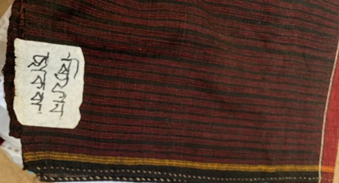
|
Figure 6 100 Years Old Riphan Chakkay |
There is another piece of unique clothes used in Rabha society. It’s a protection clothe called NEN MARANG (Figure-7). NEN means Kapur or clothes and MARANG means Bipod or danger. So literally it means “clothes in danger,” in the sense it is worn in danger to protect the wearer. As mentioned by Mr. Prakash Chandra from Amguri, Goalpara, curator and custodian of Rabha Museum. It is a small piece of clothes but to weave in one night alone, To weave this piece of clothes certain rules to be followed strictly. Without which this piece of garment has no significance or “Protective effect” as they believed. Generally, it is of 4 “hand” length and ek “beket” width. Only Red/Maroon and black colors are used and to be weaved in a night. The women who weave the garment to be “Purified” first and must wear clean clothes. She must make a spot in the east for certain rituals and light diya on banana leaf, and offer rice and banana to “Bhagwati Aai” before she is allowed to spin cotton. She must color thread and all other arrangements for weaving during the daytime. In the evening again after doing the puja she is allowed to start weaving. Not a single tread to break otherwise it loses its effects. Garments weaved on Saturday and Tuesday night are believed to have more effect. (Rajkhowa, Jan 2013) .It is believed that when someone wears this and goes to war or battle, no enemy could ever harm him, no thunder strike can do any damage, and no black magic or magic work on the wearer. He is protected from kind of danger. He said that in older times natural dyes are used to dye the yarns. These clothes are decorated with elephant teeth (ivory) as shown in the fig-7. He firmly stated that this garment is strictly worn in battle. He claims this garment is more than 500 years old. As people used homegrown cotton yarns to weave and use natural dyes to color thread, which is why these garments survived this long time and with proper care will last many more years to come. He said the wife must weave this garment for their husband. Along with this protection garment, one has to wear another piece of chain accessories that is called “Rubook mala” (figure-9).
Figure 7
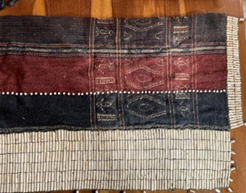
|
Figure 7 Protection Cloth Nen Marang |
Figure 8
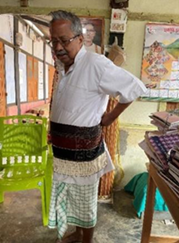
|
Figure 8 Way to Wear |
Figure 9
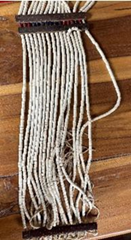
|
Figure 9 Rubook Mala |
Gamusha or Phali with Mokordoma design (Figure-10) has great significance in Rabha society and culture. It is believed if it is hung on a person’s neck, he will not lose any case in court as the name of the design suggests. Smt Lady Rabha, a national awardee (1990), shared something very significant and interesting fact that the Mokordoma paar (design in Rabha language) which held a very important in Rabha textile design and culture, was called Jaap paar before by their grandmother and all but now Pati Rabhas, which is more Assamese call it Mokordoma paar. There are certain rules to be followed before weaving this piece of clothing. There are varieties of the design like dangor (Big) and horu (small) Mokordoma paar.
Figure 10
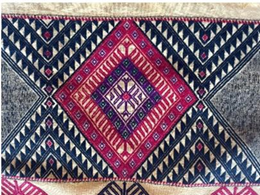
|
Figure 10 Mokordoma design |
Figure 11

|
Figure 11 A
Variety of Mokordoma Design |
Another important motif of Rabha textile is Bai paar, which is also called God’s paar. Used in special garments alone. Also known as Modhus paar (figure-12). This motif is used in Marai puja or Monokha puja. This motif is significant she elaborated, and should not be used the wrong way or wrong placement as this design is used for Puja or sacred events. It's believed that they can weave very few designs of it. if weave few one should be offered to Marai puja or else it will affect the weaver's eye.
Figure 12
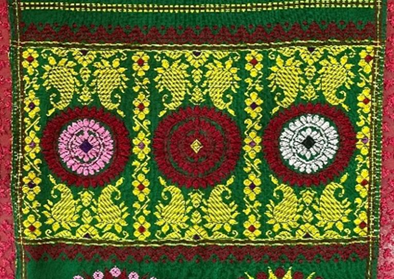
|
Figure 12 Bai or Modhus Paar also Known as God’s Design |
Kambung is a very important part of Rabha culture, worn by women in Puja and weddings. It was so important that if no Kambung then no wedding. Traditionally it was a long piece of fabric with fringes and twisted locally called maar pekua. (Figure-13) And this fringe comes in the front when worn. When a newlywed bride enters the new house, she must cover her head, and a hairpin used to wear called Khusung Makrong, made from a tortoise shell. old design was long but now it’s shortened in length. In Kambung the thick line border design is called Rin khan dokai (figure-14). It’s a must-have design for Kambung. And the middle line designs are called Nusuk bukai (figure-15), which means middle thread. The black color Kambung is used before when the bride used to come to her husband's house. Khoyari (maroon) color is also used now. In ancient times bride used to welcome in Riphan chakba but now Kambung is used. This kind of wedding kambung is with Maar Pekua. This means fringes of the cloth is interlaced at the end and the last knot is with Mantra. It works as protection clothe to the female who wears it as bride. This is unique to Rabha clothing and culture.
Kambung to tie around the body at the armpit level by married women. Kambung having a net effect (resembling leno weave) is called Jara Kambung. It is considered a sign of a real expert in weaving one who can weave the Jara Kambung.Kambung was used to carry babies back in day-to-day uses. She shared that before females never used to wear a blouse, only kambung was used to cover the torso and bust. Kambung was a long piece of fabric used to wrap the girl in the upper part but these days people wear a blouse and hardly anyone knows how to wrap it. The way it was wrapped is called Khasi Sokhai which in Rabha language means wrapping.
Figure 13

|
Figure 13 Fringes are Interlaced at the end and the Last Knot is with Mantra to Protect the Women who Wears it |
Figure 14
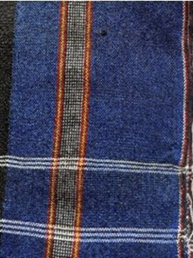
|
Figure 14 Rin Khan Dokai (Border Design) |
Figure 15
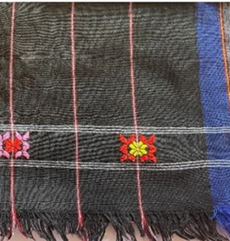
|
Figure 15 Nusuk Bukai (Middle Line Design) |
Khoprong (fig-16) is the headgear worn on the head by females while dancing and at weddings. Bride must wear compulsorily on their head. Newlywed bride used to serve food at the wedding feast, so it also helps stop hair falling while serving. It is like a chef hat for the feasting time. It is not much seen in Pati Rabha. Rongdani Rabha wears mostly. Even Riphan, and Rongdani Rabha use 3 layers and Pati Rabha mostly uses one. Khoprong is mostly black but the design could have variety. But with time people wanted change in color and design too. It also observed that people are using Khoprong as a pajar style.
Figure 16
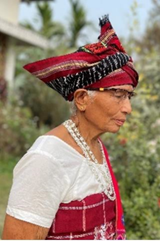
|
Figure 16 Khoprong- The Headgear |
Figure 17
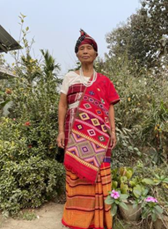
|
Figure 17 Traditional Rabha Costume (Front) |
Figure 18
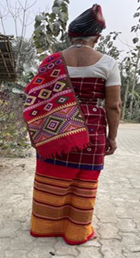
|
Figure 18 Back |
Male Gamusa or towel is called Pajal. usually, the garment is handspan. It is used to weave in white and red color combination (figure-18). Another male garment is Jhama (figure-19), a man's upper garment. It is used in battle, Forkanti dance, and Baikho puja, especially worn by the performer who runs on fire during the puja. The Shape is basic and got all straight cut but made in a way that the wearer gets good movement without discomfort. Stitches are loose and fabric is coarse in nature (figure-20). Along with Jhama, traditionally Rabha men used to wear bottom wear called Chola (figure-21). Present-day skirt-like garments used to be worn by men. Expert believed lengti (twisting and tucking the end of the wrap around to the back waist) came later but before this skirt-like garment only was used. The garment has the crinkled effect (figure- 22). Another important significant traditional piece of cloth is the headgear called Khopong (figure-23). It used to be made from eri silk fabric. This used to be a very long piece of fabric, around 18 feet long. It is mostly worn in war or battles but also worn in Baikho puja and Farkanti dance. Even At weddings this headgear is used by men made in eri silk. Usually 4 people used to help make wear this khopong as it needs to be wrapped around the head very tightly in multiple layers. Layers of fabrics are so compact and secure that when worn in war, even the enemy will not be able to cut or do any damage to the head with any weapon due to many layers. That is why it is not easy or convenient to even open and wear again. Which is why in Baikho puja. 3 days they used to wear and stay and sleep with the headgear only.
Figure 19
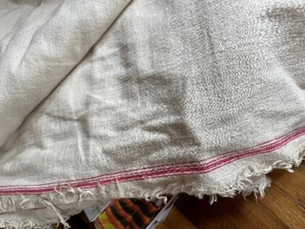
|
Figure 19 Pajal |
Figure 20

|
Figure 20 Jhama |
Figure
21
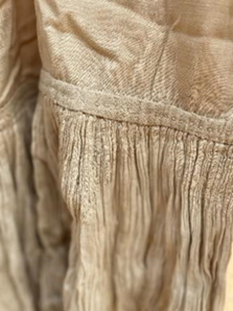
|
Figure 21 Stitches and Fabric Quality |
Figure 22
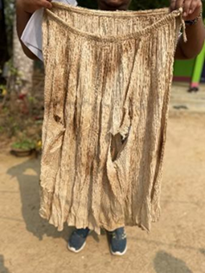
|
Figure 22 Chola-Skirt Like |
Figure 23
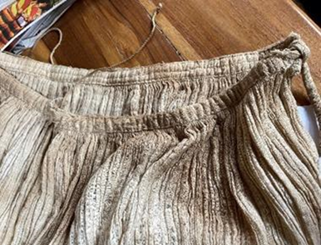
|
Figure 23 Crinkled Effect |
Figure 24
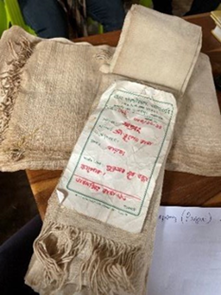
|
Figure 24 Traditional Headgear Men’s Bottom Wear Called Khopong |
Rabha people use Laha /red color more. It is believed that as Rabha is an agrarian society, white working in the field their garments used gets dirty easily.so they used dark colors mostly so that they don’t have to worry about their clothes getting dirty while working. Though red color is favorite for Rabha, but it has certain restriction in uses too. For example, red is barred using when go for hunting, especially when going tiger hunting. Red color gives the blood-a-look and feel and tiger may be attracted more and attack. Later green color has also been used significantly. A particular shade of green which is like parrot green is used more and it's called Bhatok kren (feather). Traditionally at weddings, males used to wear Jhama and Paguri. later male started using Pajar n Khopong like a scarf on their neck.
4. Conclusion and recommendation
It is interesting to see how we humans, since time immemorial constructed a society. We live in, and develop a relationship with the clothes they weave and use. How a particular design of clothes and costumes communicates to a society creating a visual communication through design. In Rabha society, their traditional costume plays a significant role in communicative creations, traditions rituals, and cultures among them, certain customs and cultures have been passed down from generation to generation through these clothes. It can be safely said that clothes and clothing play a very important role in a tribal society to carry the identity and material center of the tribe. In research, it has been found that motif, color, and clothing have a lot of significance and relevance in the Rabha society.
To conclude, it may be safely said that Traditional designs carry symbolic meaning that conveys an important message within the society. Colors, patterns, and motifs of traditional textiles of that tribe represent elements such as social status, marital status, social roles, spiritual beliefs, good luck, protection, religious beliefs, and more.
This study can be further taken to other tribes as well to understand the visual characteristics of traditional folk textile motifs, color, and clothing. This will help us understand the importance of textile and clothing design in a social context and the human psyche concerning the society they belong.
As tribal societies are revolving around nature, traditional clothes are always made with natural ways, be it dying, spinning, weaving or even the way it’s been worn. Their way of life with regards to costume n clothing can further be studied with sustainability frame work.
CONFLICT OF INTERESTS
None.
ACKNOWLEDGMENTS
None.
REFERENCES
Anon., 2022.
des.assam.gov.in/information-service. [Online]
Available at: n
2020. Custom law and penal code of the Rabha society. Dudhnoi.: RHAC.
B.N. Bordoloi, G.
T., n.d. Tribes of Assam, Part-I. s.l.:s.n.
Baglary, M., 2022.
MARRIAGE SYSEM AMONG THE TOTOLA RABHAS: A BRIEF STUDY.
International
Journal of Creative Research Thoughts.
G.C.Kakoti, n.d.
<aterial cultural heritage of the tribes of Assam. s.l.:s.n.
Rabha, D., n.d.
Rabha Jonojatir Chomu Itihakh. s.l.:s.n.
Rabha, H., 2021.
Hannaghora Dance Prevelant Amoing Rava community Of Assam-An Overview.
PalArch's Journal
Of Archaeology of Egypt / Egyptology.
Sarkar, H., n.d.
Rabha Homaj Aru Sanskritir Abhakh. s.l.:s.n.
Sen, A., 2016.
SOME BASIC OBSERVATION ON THE RABHA SOCIETY AND CULTURE. Indian
|
|
 This work is licensed under a: Creative Commons Attribution 4.0 International License
This work is licensed under a: Creative Commons Attribution 4.0 International License
© ShodhKosh 2024. All Rights Reserved.

